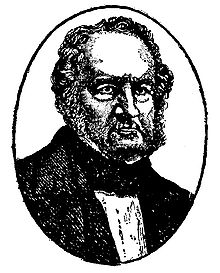Bernhard von Beskow
You can helpexpand this article with text translated fromthe corresponding articlein Swedish.(July 2020)Click [show] for important translation instructions.
|
Bernhard von Beskow | |
|---|---|
 Portrait (oil on canvas) byOlaf Johan Södermark(1830) | |
| Born | 19 April 1796 Stockholm,Sweden |
| Died | 17 October 1868(aged 72) Stockholm,Sweden |
| Occupation | Dramatist, historian |
| Nationality | Swedish |
Bernhard von Beskow(19 April 1796 – 17 October 1868) was aSwedishdramatist and historian.
Born inStockholmand the son of amerchant,his vocation for literature was assisted by his tutor, the poetJohan Magnus Stjernstolpe(1777–1831), whose works he edited. He entered thecivil servicein 1814, was ennobled in 1826 and received the title ofbaronin 1843. He held high appointments at court, and was, from 1834 onward, perpetual secretary of theSwedish Academy,using his great influence with tact and generosity.[1]He was elected a member of theRoyal Swedish Academy of Sciencesin 1836.[2]
He produced a series of plays based on Swedish history.[3]He was the most respectable exponent of romantic historical play which became popular with Swedish audiences.[4]His works include many academical memoirs, volumes of poems, philosophy and a historical study,Om Gustav den tredje såsom Konung och Menniska(5 vols, 1860–1869,Gustavus IIIas king and man), printed in the transactions of the Swedish Academy (vols 32, 34, 37, 42, 44).[1]
According to theEncyclopædia Britannica Eleventh Edition:"His poetry is over-decorated, and his plays are grandiose historical poems in dramatic form. Among them areErik XIV(2 parts, 1826);[5]and four pieces collected (1836–1838) asDramatiska Studier,the most famous of which is the tragedy ofTorkel Knutsson."[1]
He became a member ofPro Fide et Christianismo,a Christian education society, in 1852.[6]
He died in Stockholm in 1868.
References[edit]
- ^abcOne or more of the preceding sentences incorporates text from a publication now in thepublic domain:Chisholm, Hugh,ed. (1911). "Beskow, Bernhard von".Encyclopædia Britannica.Vol. 3 (11th ed.). Cambridge University Press. pp. 820–821.This refers to a notice byCarl David af Wirsénin hisLefnadsteckningar(Stockholm, 1901).
- ^Holland, Henry Scott (20 Oct 2011).Memoir of Madame Jenny Lind-Goldschmidt: Her Early Art-Life and Dramatic Career, 1820-1851.Cambridge: Cambridge University Press. p. 87.ISBN978-1-108-03868-3.Retrieved9 March2022.
- ^Scobbie, Irene (11 May 2010).The A to Z of Sweden.Washington, DC: Rowman & Littlefield. p. 221.ISBN978-0-810-87218-9.Retrieved9 March2022.
- ^Mortensen, Brita M. E (2 Jan 1965).Strindberg.Cambridge: Cambridge University Press. p. 92.ISBN978-0-521-09260-9.Retrieved9 March2022.
- ^Warme, Lars G. (1 Jan 1996).A History of Swedish Literature.Lincoln, Nebraska: U of Nebraska Press. p. 200.ISBN978-0-803-24750-5.Retrieved9 March2022.
- ^Simonsson, Ivar."Bernhard Beskow, von".Svenskt Biografiskt Lexikon(in Swedish).Retrieved2022-06-16.
- 1796 births
- 1868 deaths
- Writers from Stockholm
- Swedish male writers
- 19th-century Swedish historians
- Members of the Swedish Academy
- Members of the Royal Swedish Academy of Sciences
- Swedish nobility
- Members of the Royal Swedish Academy of Arts
- Swedish male dramatists and playwrights
- 19th-century Swedish dramatists and playwrights
- 19th-century male writers
